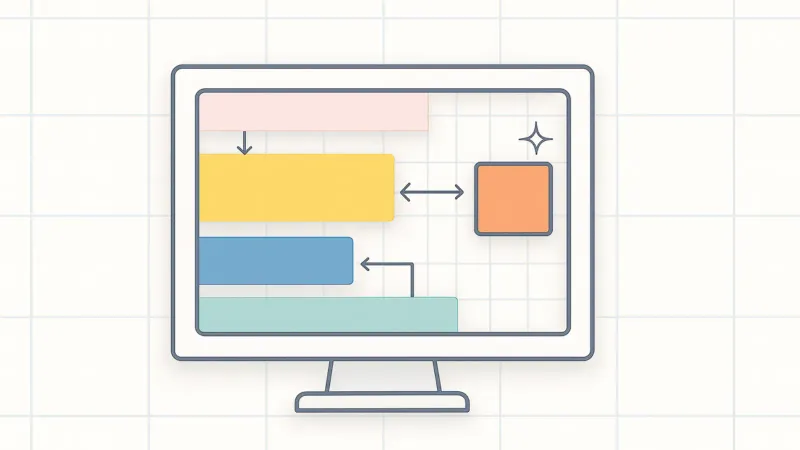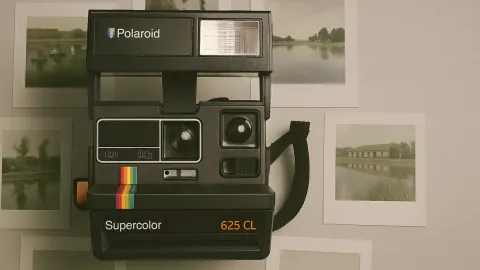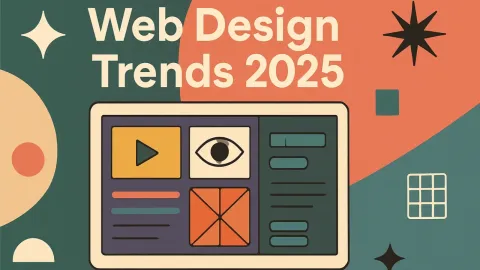Master CSS Position: 5 Positioning Methods for Unique Layouts

Quick Answer
CSS Position has 5 positioning methods: static (default), relative (relative positioning), absolute (absolute positioning), fixed (fixed positioning), and sticky (sticky positioning). Each serves different purposes, and mastering them enables unique layout effects.
CSS Position Fundamentals
Want to break away from traditional web layout patterns? CSS Position is your ultimate tool! By cleverly utilizing the five positioning methods, you can create offset, asymmetric, layered, and various visual effects that make website designs more creative and appealing.
CSS Position has five values: static, relative, absolute, fixed, and sticky. Each has different behaviors and purposes, and understanding their differences is key to creating outstanding layouts.
Static Positioning - The Default Behavior
position: static is the default value for all HTML elements. Elements with static positioning follow the normal document flow, arranged from top to bottom, left to right.
Key characteristics:
- Follows document flow: Elements are arranged according to HTML structure
- Ignores positioning properties:
top,right,bottom,lefthave no effect - Default z-index: Cannot use z-index to control stacking order
Static Positioning Demo
Static Element #1
Static Element #2
Static Element #3
Note: top: 50px, left: 50px have no effect on static elements
As you can see, even though we set top: 50px and left: 50px, the static elements remain in their normal document flow positions.
Basic Static Positioning Syntax
.static-element {
position: static; /* Default value */
/* top, left, right, bottom have no effect on static elements */
top: 50px; /* ❌ Ignored */
left: 50px; /* ❌ Ignored */
z-index: 999; /* ❌ Ignored */
}Relative Positioning - Offset from Original Position
position: relative allows elements to offset from their original position while maintaining their space in the document flow. This creates a “positioning context” for absolutely positioned child elements.
Key characteristics:
- Maintains document flow: Original space is preserved
- Creates positioning context: Becomes reference point for absolute children
- Accepts positioning properties:
top,right,bottom,leftwork as offsets
Relative Positioning Comparison
Notice how Box 2 moves from its original position (top: 20px, left: 30px), but its original space in the document flow is preserved, preventing other elements from moving up.
Relative Positioning Syntax
.relative-element {
position: relative;
top: 20px; /* ✅ Moves 20px down from original position */
left: 30px; /* ✅ Moves 30px right from original position */
z-index: 1; /* ✅ Can control stacking order */
}
/* Creates positioning context for absolute children */
.relative-parent {
position: relative; /* Reference point for absolute children */
}
.absolute-child {
position: absolute;
top: 0; /* Relative to .relative-parent */
right: 0; /* Relative to .relative-parent */
}Absolute Positioning - Removed from Document Flow
position: absolute removes elements from the normal document flow and positions them relative to the nearest positioned ancestor (an element with position other than static).
Key characteristics:
- Removed from document flow: Doesn’t affect other elements’ positions
- Positions relative to ancestor: Uses nearest positioned parent as reference
- Full positioning control: Can use all four positioning properties
Absolute Positioning Demo
Document Flow Impact: This content comes after the absolute container in HTML, but absolute elements don’t affect its position.
Try hovering over the absolute boxes! They’re positioned precisely relative to their container without affecting the normal document flow.
Absolute Positioning Syntax
/* Container with positioning context */
.container {
position: relative; /* Creates positioning context */
height: 300px;
width: 100%;
}
/* Absolutely positioned elements */
.absolute-element {
position: absolute;
top: 50px; /* ✅ 50px from top of positioned ancestor */
left: 20px; /* ✅ 20px from left of positioned ancestor */
right: 30px; /* ✅ 30px from right of positioned ancestor */
bottom: 40px; /* ✅ 40px from bottom of positioned ancestor */
z-index: 10; /* ✅ Controls stacking order */
}
/* Common absolute positioning patterns */
.top-left {
position: absolute;
top: 0;
left: 0;
}
.center-absolute {
position: absolute;
top: 50%;
left: 50%;
transform: translate(-50%, -50%); /* Perfect centering */
}
.bottom-right {
position: absolute;
bottom: 0;
right: 0;
}Fixed Positioning - Relative to Viewport
position: fixed positions elements relative to the browser viewport. Fixed elements remain in the same position even when the page scrolls, making them perfect for navigation bars, floating buttons, or notifications.
Key characteristics:
- Viewport reference: Always positions relative to browser window
- Scroll independent: Stays in place during page scroll
- Removed from flow: Like absolute, doesn’t affect other elements
Fixed Positioning Simulation
Fixed Header (simulated with sticky)
👆 The header above stays fixed while you scroll
Section 1: Understanding Fixed Positioning
Fixed positioning is perfect for navigation bars, floating action buttons, and modal overlays. The element is positioned relative to the viewport, meaning it stays in the same visual position regardless of scrolling.
Section 2: Common Use Cases
Fixed headers, sidebars, floating chat widgets, back-to-top buttons, and cookie notices are all excellent candidates for fixed positioning.
Section 3: Performance Considerations
Fixed elements can trigger repaints during scroll. Use transform and opacity for animations, and consider will-change property for better performance.
Section 4: Responsive Design
Fixed positioning works well with responsive design, but be mindful of small screens where fixed elements might cover too much content.
Scroll the container above to see how the fixed header and button remain in position. In a real webpage, these would stay fixed relative to the browser window.
Fixed Positioning Syntax
/* Fixed header that stays at top during scroll */
.fixed-header {
position: fixed;
top: 0; /* ✅ Always 0px from viewport top */
left: 0; /* ✅ Always 0px from viewport left */
right: 0; /* ✅ Stretch full width */
z-index: 1000; /* ✅ Above other content */
background: white;
box-shadow: 0 2px 4px rgba(0,0,0,0.1);
}
/* Fixed floating button */
.floating-button {
position: fixed;
bottom: 20px; /* ✅ Always 20px from viewport bottom */
right: 20px; /* ✅ Always 20px from viewport right */
z-index: 999;
background: #007bff;
border: none;
border-radius: 50px;
padding: 1rem;
}
/* Fixed sidebar */
.fixed-sidebar {
position: fixed;
top: 0;
left: 0;
height: 100vh; /* Full viewport height */
width: 250px;
background: #f8f9fa;
overflow-y: auto; /* Scrollable content */
}
/* Fixed modal overlay */
.modal-overlay {
position: fixed;
top: 0;
left: 0;
right: 0;
bottom: 0; /* Cover entire viewport */
background: rgba(0,0,0,0.5);
z-index: 10000;
}Sticky Positioning - Best of Both Worlds
position: sticky combines relative and fixed positioning. The element starts as relatively positioned, then becomes fixed when it reaches a specified scroll position.
Key characteristics:
- Hybrid behavior: Switches between relative and fixed
- Scroll threshold: Activates at specified offset
- Container bound: Sticks within its parent container
Sticky Positioning with Progress Indicator
Understanding Sticky Positioning
Sticky positioning is like having a smart element that knows when to stick and when to flow. It’s particularly useful for table headers, section navigation, and progress indicators.
Browser Support
Sticky positioning has excellent modern browser support. For older browsers, you can use polyfills or fall back to JavaScript-based solutions.
Performance Benefits
Unlike JavaScript scroll listeners, sticky positioning is handled natively by the browser, resulting in better performance and smoother animations.
Common Pitfalls
Remember that sticky elements need a threshold value (top, bottom, etc.) and will only stick within their containing block. Parent elements with overflow: hidden can break sticky behavior.
Real-world Applications
Sticky positioning is perfect for navigation menus, table headers, progress bars, floating toolbars, and section dividers in long articles.
Notice how the progress bar updates as you scroll, and the sidebar sticks to position when it reaches the top threshold!
Sticky Positioning Syntax
/* Basic sticky positioning */
.sticky-header {
position: sticky;
top: 0; /* ✅ Sticks when reaching 0px from top */
z-index: 100;
background: white;
border-bottom: 1px solid #eee;
}
/* Sticky sidebar that sticks after scrolling past header */
.sticky-sidebar {
position: sticky;
top: 80px; /* ✅ Sticks 80px from viewport top */
height: fit-content;
max-height: calc(100vh - 100px); /* Prevent overflow */
overflow-y: auto;
}
/* Sticky table headers */
.sticky-table th {
position: sticky;
top: 0;
background: white;
z-index: 10;
}
/* Multiple sticky thresholds */
.sticky-nav {
position: sticky;
top: 60px; /* Below fixed header */
background: #f8f9fa;
}
.sticky-footer {
position: sticky;
bottom: 0; /* ✅ Sticks to bottom */
background: white;
border-top: 1px solid #eee;
}
/* ❌ Common pitfall: Parent with overflow hidden breaks sticky */
.broken-sticky-parent {
overflow: hidden; /* This breaks sticky behavior! */
}
.working-sticky-parent {
overflow: visible; /* ✅ Allows sticky to work */
}Practical Application: Interactive Card Stack
Let’s combine positioning techniques to create an impressive interactive card stack effect using absolute positioning and z-index control.
Interactive Layered Cards
Try clicking on cards to bring them to the front, hover for scaling effects, and use the control buttons to shuffle or reset positions!
CSS Position Best Practices
Now that you understand all positioning methods, let’s explore best practices for optimal results:
Performance Optimization:
- Use
transforminstead of changingtop/leftfor animations - Apply
will-change: transformfor elements that will be animated - Avoid excessive nesting of positioned elements
Accessibility Considerations:
- Ensure fixed/sticky elements don’t cover important content
- Maintain proper focus order when using absolute positioning
- Test with screen readers and keyboard navigation
Responsive Design Tips:
- Use percentage values and viewport units for flexible positioning
- Consider how positioned elements behave on different screen sizes
- Use media queries to adjust positioning for mobile devices
Common Pitfalls to Avoid:
- Forgetting that absolute elements need a positioned parent
- Using z-index without understanding stacking contexts
- Overusing fixed positioning on mobile devices
- Not considering content overflow with absolute elements
Browser Compatibility:
- Sticky positioning has excellent modern browser support (95%+)
- Use feature queries
@supportsfor progressive enhancement - Consider polyfills for older browser support if needed
Conclusion: Mastering CSS Position
CSS Position is a powerful tool that opens up countless design possibilities. By understanding the five positioning methods - static, relative, absolute, fixed, and sticky - you can create sophisticated layouts that were previously only possible with JavaScript.
Key takeaways:
- Static: Default behavior, follows document flow
- Relative: Creates positioning context, offsets from original position
- Absolute: Removed from flow, positions relative to ancestor
- Fixed: Always relative to viewport, perfect for UI elements
- Sticky: Smart positioning that switches between relative and fixed
Remember to always consider performance, accessibility, and responsive behavior when implementing positioned layouts. Start with simple positioning and gradually build up to complex interactive effects.
With these techniques in your toolkit, you’re ready to create unique, engaging web layouts that stand out from the crowd!
Essential Position Code Snippets
/* 🎯 Perfect Centering (Works for any size element) */
.center-perfect {
position: absolute;
top: 50%;
left: 50%;
transform: translate(-50%, -50%);
}
/* 📱 Responsive Fixed Navigation */
.responsive-nav {
position: fixed;
top: 0;
left: 0;
right: 0;
z-index: 1000;
background: white;
padding: 1rem;
box-shadow: 0 2px 10px rgba(0,0,0,0.1);
}
@media (max-width: 768px) {
.responsive-nav {
padding: 0.5rem;
}
}
/* 🔄 Overlay Pattern */
.overlay {
position: fixed;
top: 0;
left: 0;
right: 0;
bottom: 0;
background: rgba(0,0,0,0.7);
display: flex;
align-items: center;
justify-content: center;
z-index: 9999;
}
/* 📌 Badge/Notification Positioning */
.badge {
position: absolute;
top: -10px;
right: -10px;
background: red;
color: white;
border-radius: 50%;
width: 20px;
height: 20px;
display: flex;
align-items: center;
justify-content: center;
font-size: 12px;
}
/* 🚀 Floating Action Button */
.fab {
position: fixed;
bottom: 20px;
right: 20px;
width: 56px;
height: 56px;
border-radius: 50%;
background: #007bff;
color: white;
border: none;
box-shadow: 0 4px 20px rgba(0,123,255,0.4);
transition: transform 0.3s ease;
}
.fab:hover {
transform: scale(1.1);
}


